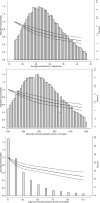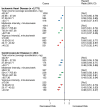Accelerometer measured physical activity and the incidence of cardiovascular disease: Evidence from the UK Biobank cohort study
- PMID: 33434193
- PMCID: PMC7802951
- DOI: 10.1371/journal.pmed.1003487
Accelerometer measured physical activity and the incidence of cardiovascular disease: Evidence from the UK Biobank cohort study
Erratum in
-
Correction: Accelerometer measured physical activity and the incidence of cardiovascular disease: Evidence from the UK Biobank cohort study.PLoS Med. 2021 Sep 29;18(9):e1003809. doi: 10.1371/journal.pmed.1003809. eCollection 2021 Sep. PLoS Med. 2021. PMID: 34587151 Free PMC article.
Abstract
Background: Higher levels of physical activity (PA) are associated with a lower risk of cardiovascular disease (CVD). However, uncertainty exists on whether the inverse relationship between PA and incidence of CVD is greater at the highest levels of PA. Past studies have mostly relied on self-reported evidence from questionnaire-based PA, which is crude and cannot capture all PA undertaken. We investigated the association between accelerometer-measured moderate, vigorous, and total PA and incident CVD.
Methods and findings: We obtained accelerometer-measured moderate-intensity and vigorous-intensity physical activities and total volume of PA, over a 7-day period in 2013-2015, for 90,211 participants without prior or concurrent CVD in the UK Biobank cohort. Participants in the lowest category of total PA smoked more, had higher body mass index and C-reactive protein, and were diagnosed with hypertension. PA was associated with 3,617 incident CVD cases during 440,004 person-years of follow-up (median (interquartile range [IQR]): 5.2 (1.2) years) using Cox regression models. We found a linear dose-response relationship for PA, whether measured as moderate-intensity, vigorous-intensity, or as total volume, with risk of incident of CVD. Hazard ratios (HRs) and 95% confidence intervals for increasing quarters of the PA distribution relative to the lowest fourth were for moderate-intensity PA: 0.71 (0.65, 0.77), 0.59 (0.54, 0.65), and 0.46 (0.41, 0.51); for vigorous-intensity PA: 0.70 (0.64, 0.77), 0.54 (0.49,0.59), and 0.41 (0.37,0.46); and for total volume of PA: 0.73 (0.67, 0.79), 0.63 (0.57, 0.69), and 0.47 (0.43, 0.52). We took account of potential confounders but unmeasured confounding remains a possibility, and while removal of early deaths did not affect the estimated HRs, we cannot completely dismiss the likelihood that reverse causality has contributed to the findings. Another possible limitation of this work is the quantification of PA intensity-levels based on methods validated in relatively small studies.
Conclusions: In this study, we found no evidence of a threshold for the inverse association between objectively measured moderate, vigorous, and total PA with CVD. Our findings suggest that PA is not only associated with lower risk for of CVD, but the greatest benefit is seen for those who are active at the highest level.
Conflict of interest statement
I have read the journal's policy and the authors of this manuscript have the following competing interests: KR has in the past received personal fees as Associate Editor for PLOS Medicine and as Associate Editor, is in receipt of Personal Fees from BMJ Heart. MW is a consultant to Amen and Kirin. RW is supported by a Medical Research Council Industrial Strategy Studentship (grant number MR/S502509/1). The Medical Research Council had no role in the study design; collection, analysis, and interpretation of data; writing of the paper; and/or decision to submit for publication.
Figures




References
-
- Department of Health and Social Care Lywodraeth Cymru Welsh Government, Department of Health Northern Ireland and the Scottish Government. UK Chief Medical Officers’ Physical Activity Guidelines. 2019. Available from: https://assets.publishing.service.gov.uk/government/uploads/system/uploa....
Publication types
MeSH terms
Substances
Grants and funding
- MR/S502509/1/MRC_/Medical Research Council/United Kingdom
- MC_QA137853/MRC_/Medical Research Council/United Kingdom
- RP-PG-0407-10314/DH_/Department of Health/United Kingdom
- MR/M501633/2/MRC_/Medical Research Council/United Kingdom
- MR/K006584/1/MRC_/Medical Research Council/United Kingdom
- WT_/Wellcome Trust/United Kingdom
- MC_PC_17228/MRC_/Medical Research Council/United Kingdom
- 001/WHO_/World Health Organization/International
- 05/40/04/DH_/Department of Health/United Kingdom
- MC_PC_13041/MRC_/Medical Research Council/United Kingdom
- G0902393/MRC_/Medical Research Council/United Kingdom
- SP/18/4/33803/BHF_/British Heart Foundation/United Kingdom
LinkOut - more resources
Full Text Sources
Other Literature Sources
Medical
Research Materials
Miscellaneous

